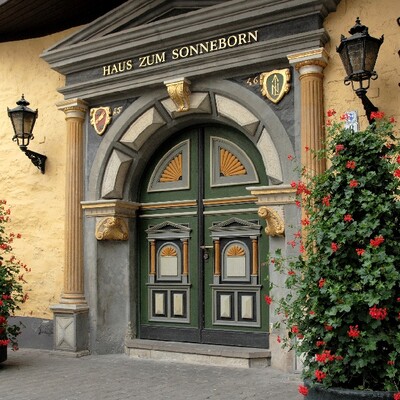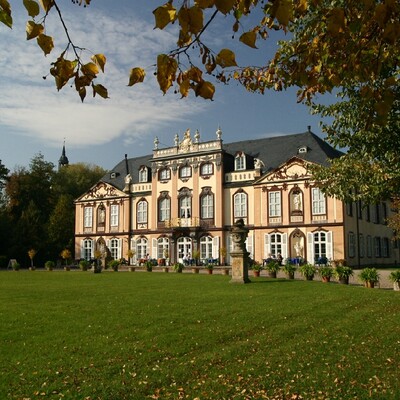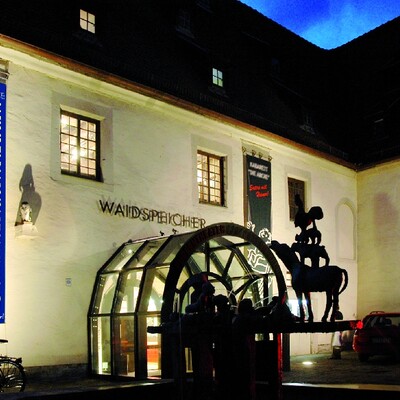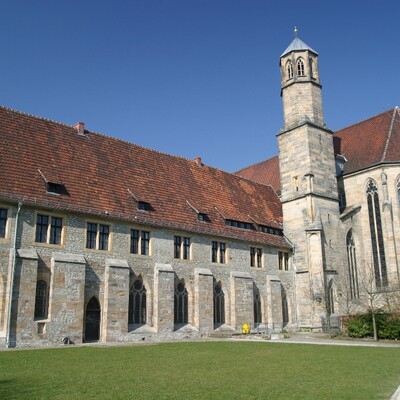Places of interest
Erfurt - a destination of distinction
Discover the city's many cultural and architectural treasures and succumb to the charms of Erfurt's romantic old quarter: Germany's largest single heritage site is a popular spot for locals and tourists alike, thanks to its medieval architecture and fascinating history.
With its ancient abbey, magnificent churches, the Erfurt Treasure and grand patrician town houses, this is a city that lets you live and breathe history.
8 places to visit in Erfurt

Cathedral of St. Mary
The late Gothic cathedral with its high-Gothic choir and Romanesque tower replaced the church built on this site for Bishop Boniface in 742.

Church of St. Severus
The Church of St Severus, a five-naved early Gothic hall church, is Erfurts most famous landmark - along with the cathedral.

Merchants' Bridge
Another Erfurt landmark is the Merchants' Bridge (Krämerbrücke), the longest series of inhabited buildings on any bridge in Europe.

Old Synagogue (UNESCO World Heritage)
The Old Synagogue is one of the very few preserved medieval synagogues in Europe and among the most impressive architectural monuments in Erfurt and Thuringia.

Petersberg Citadel
Petersberg Citadel, the only extensively preserved town baroque fortress in central Europe, was built on the site of a former Benedictine monastery.

Erfurt Protestant Augustinian Monastery
The church and monastery was built around 1300. Martin Luther, the famous Augustinian monk, was admitted to the monastery on 17 July 1505.

egapark Erfurt
"Thuringia’s most beautiful garden" has parkland, gardens, conservatories, a butterfly house, a children’s farm, an adventure playground and a great deal more.

Thuringian Zoo
More than 1.100 animals from every continent, including African elephants, white rhinos, giraffes and a variety of monkeys, are accommodated here.
Other sights worth discovering:

Haus zum Sonneborn
Today this building is used as a registry office and for weddings. The magnificent portal has been preserved through restoration work.

The neo-Gothic town hall on Fischmarkt was built between 1870 and 1874.
The neo-Gothic town hall on Fischmarkt was built between 1870 and 1874. Inside is a series of murals depicting legends and images from Erfurts history.

Imperial Hall
The Imperial Hall was built in 1715 as the university ballroom. In 1808 Napoleon I and Tsar Alexander I of Russia met here for the Royal Congress.

Memorial and Educational Site Andreasstraße
The Andreasstraße memorial and educational site commemorates oppression and resistance during the SED dictatorship in Thuringia from 1949-1989.

Collegium Maius
Collegium Maius was in formaer times the main building of the Old Universitiy of Erfurt.

Molsdorf Palace and Park
The late-baroque Molsdorf Palace and its beautiful park - also known as the "Thuringian Versailles" - are in Molsdorf on the outskirts of Erfurt.

Woad Storehouse
Woad contributed to Erfurt's prosperity in medieval times. It has been cultivated in the Thuringian Basin and processed and traded here since the 13th century.

Medieval Mikveh
The Old Synagogue features a medieval mikveh, a type of Jewish ritual bath.
Former Governors Residence
Built between 1711 and 1720 and designed by architect Maximilian von Welsch, today it accommodates Thuringia's State Chancellery.

St. Bartholomews Tower
St Bartholomews Tower is the only remaining part of the former St. Bartholomews Church, which was one of the oldest churches in Erfurt (recorded in 1182).

Georgenburse
It is widely accepted that Martin Luther, moved into the Georgenburse (student living quarters) as a seventeen-year-old student in April 1501.

Junkersand
Junkersand Erfurt – an idyllic spot by the water where Johann Sebastian Bach once worked. A historic place of tranquillity surrounded by greenery, centrally located in Erfurt.
Churches in Erfurt:

Prediger Church
The church of the Dominican or Prediger (preacher) monks was built in several stages between 1270 and 1400.

Monastery church of St. Peter and Paul
Despite significant alterations to the structure of the former monastery church of St. Peter and Paul in the 19th century, it is still one of the most important Romanesque church buildings in Thuringia.

St. Michael's Church Erfurt
St. Michael's Church was built at the end of the 13th century and became a university church in 1392. Concerts on the Compenius organ and in St. Michael's Churchyard are very popular.

Merchant's Church
The Romanesque predecessor of the parish church from the 11th century, documented in 1248, was consecrated in 1364 as a three-nave Gothic basilica after the town fire of 1291.

Thomas church
St. Thomas Church in Erfurt – historic, central and impressive. A quiet place with a rich history in the heart of the old town.






